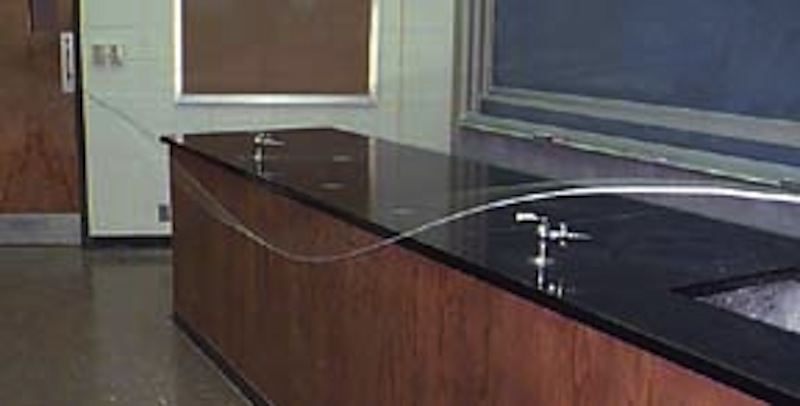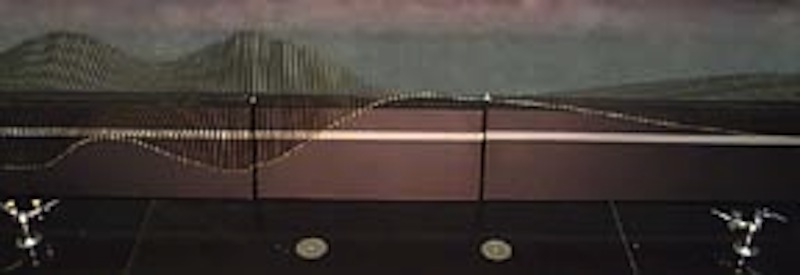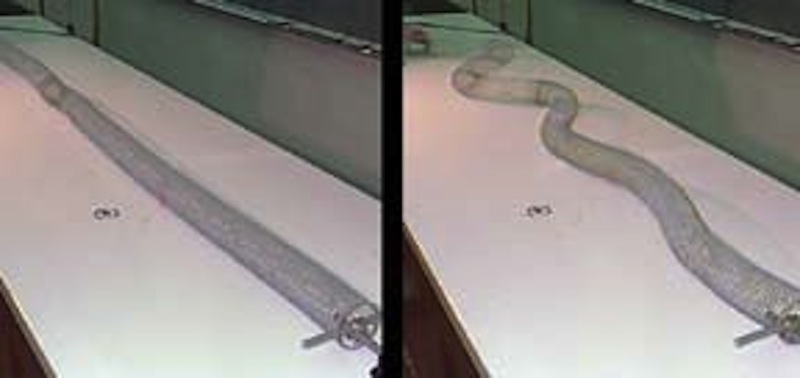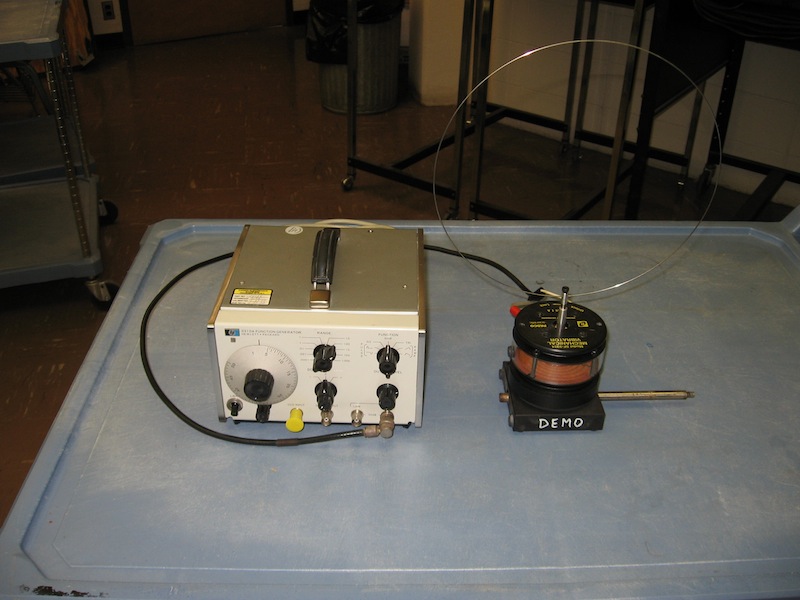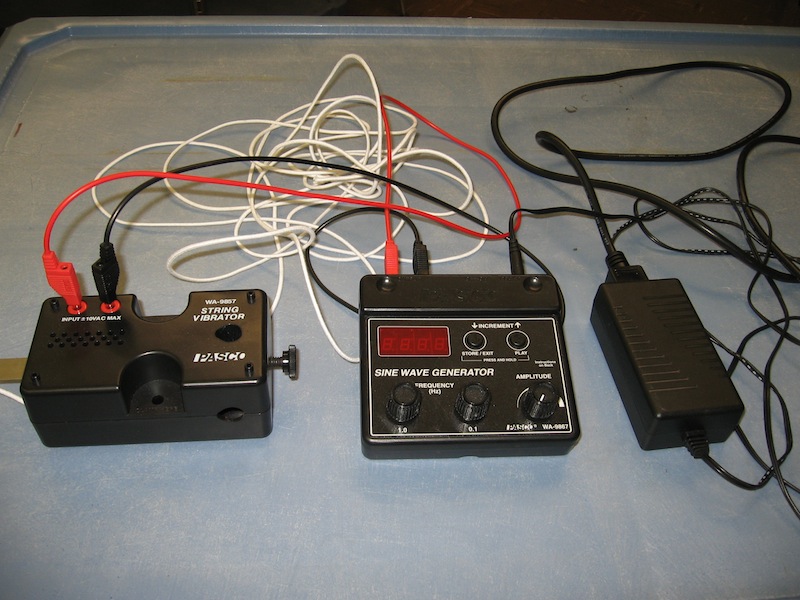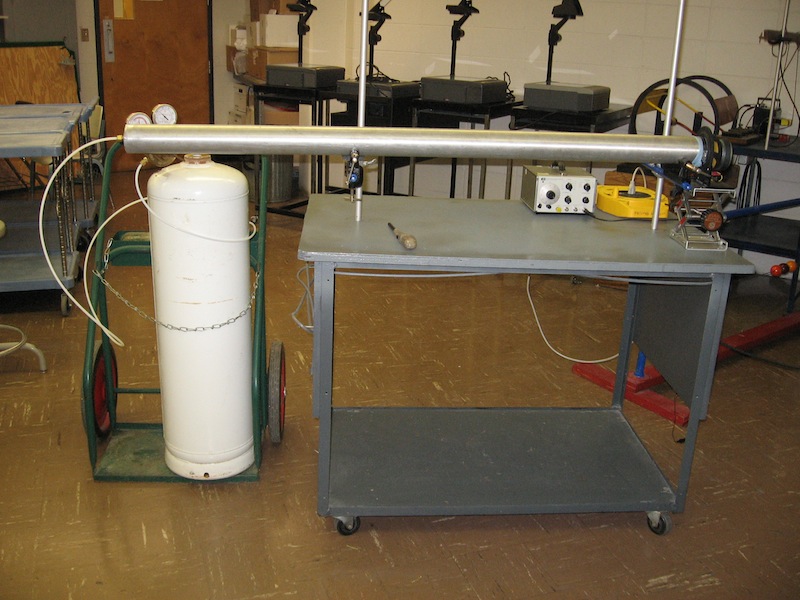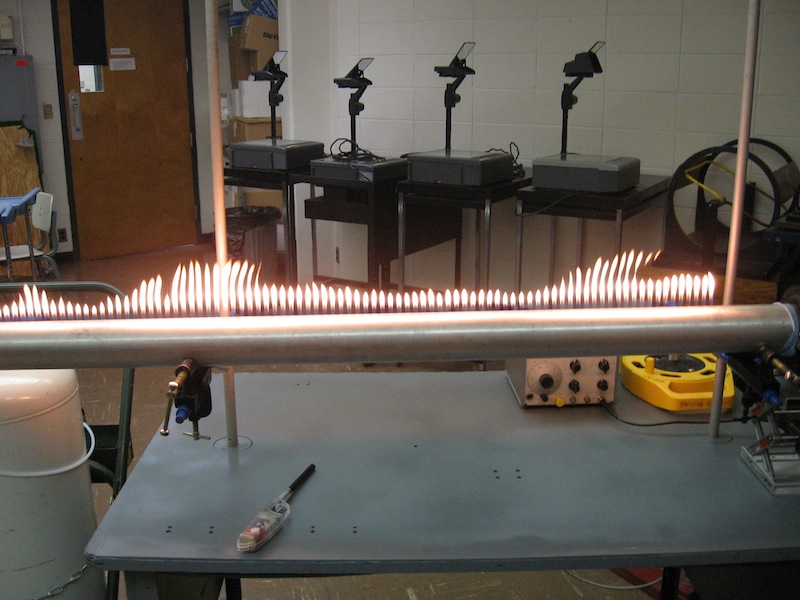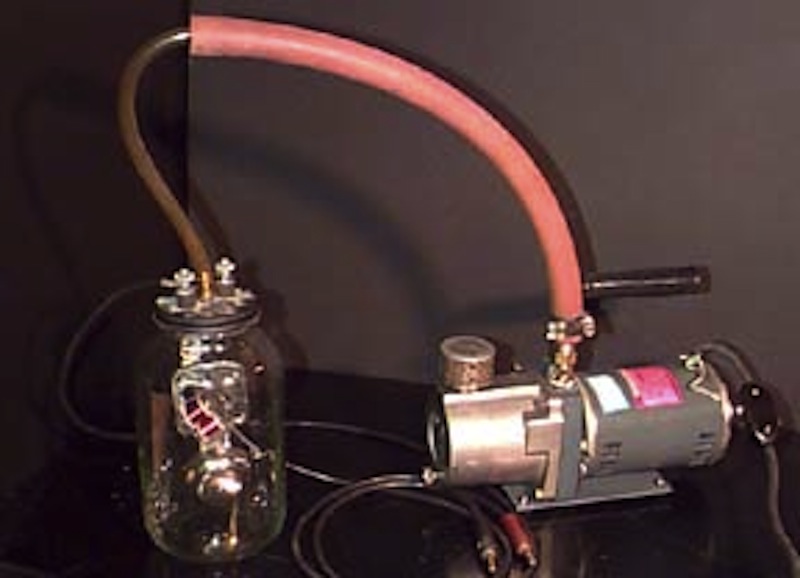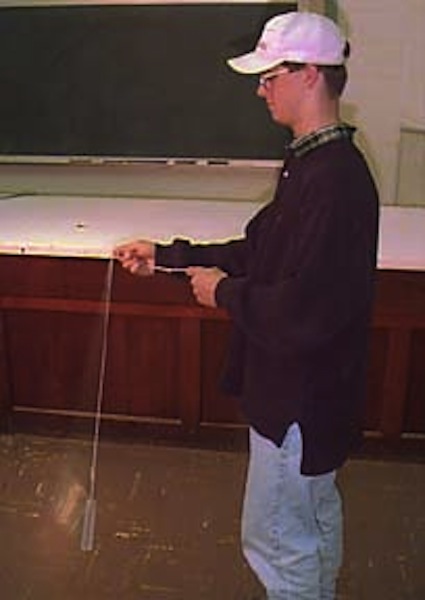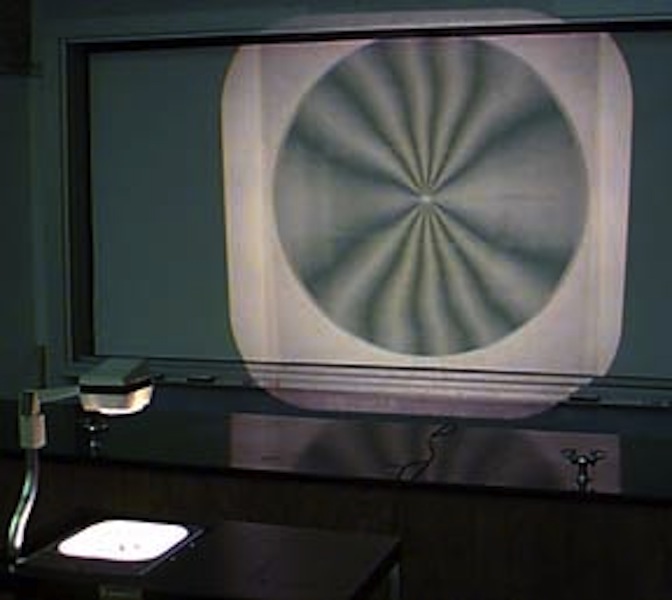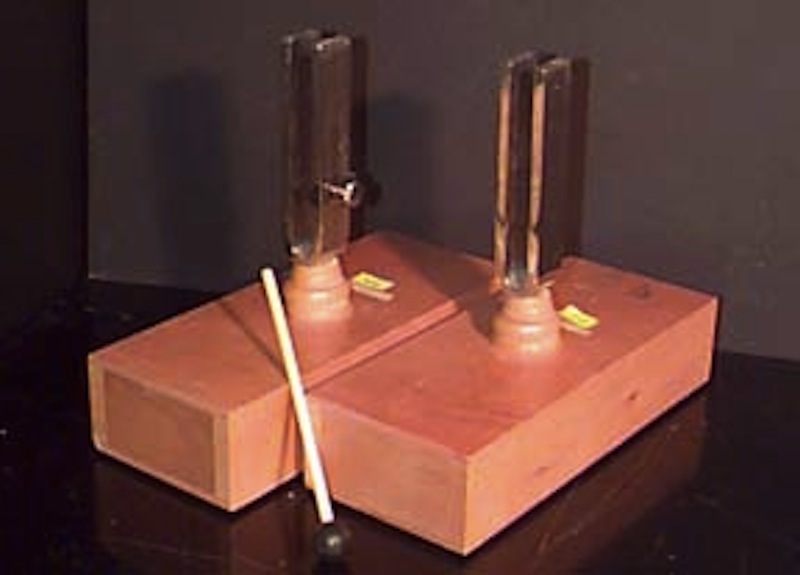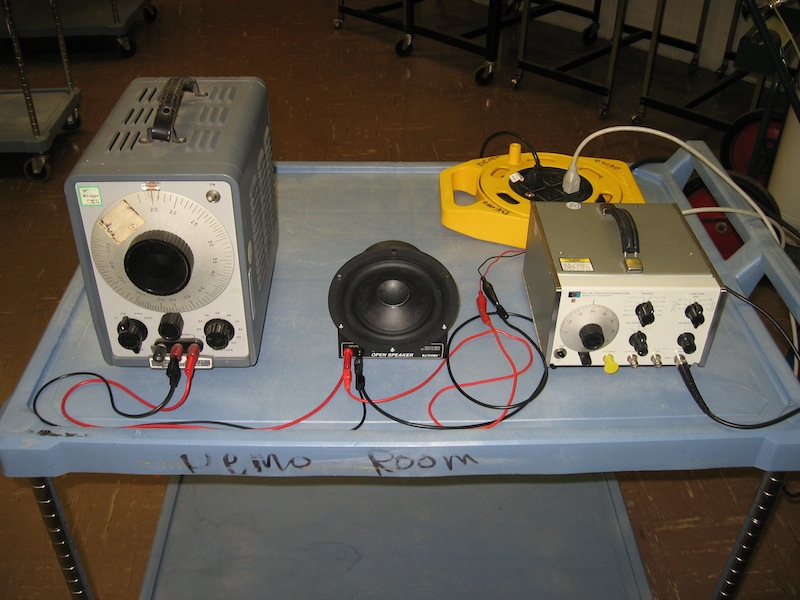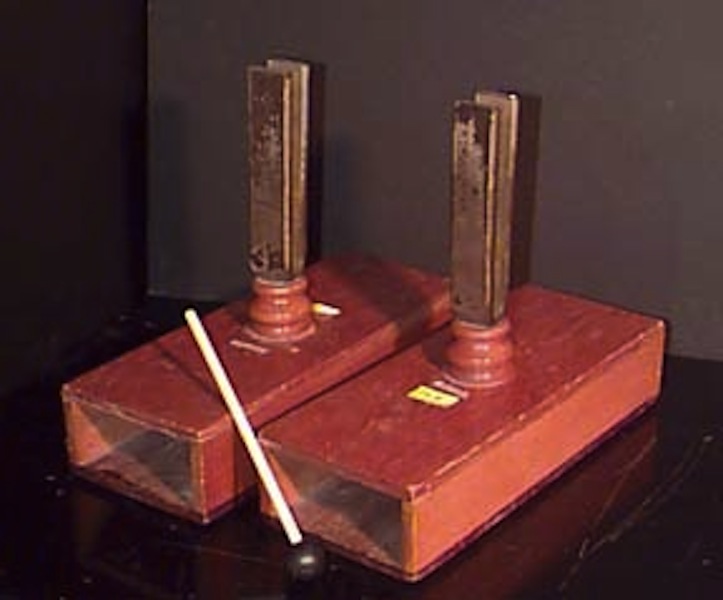COSAM » Departments » Physics » Introductory Courses » Demonstrations » Waves and Resonance » Wave Motion
WAVE MOTION
3B10.10 PULSE ON ROPE (or spring)3B10.30 SHIVE (BELL LABS) WAVE MODEL
3B20.10 PULSE ON SLINKY
3B22.10 STANDING WAVES IN STRING
3B22.11 STANDING WAVES IN METAL RING
3B22.12 STANDING WAVES IN LONG STRING
3B22.14 STANDING WAVES USING RUBEN'S FLAME TUBE
3B30.30 BELL IN VACUUM
3B40.10 DOPPLER EFFECT USING BUZZER
3B50.40 MOIRE PATTERN TRANSPARENCIES
3B60.10 BEAT NOTES USING TUNING FORKS
3B60.20 BEAT NOTES USING FUNCTION GENERATORS
3B70.10 COUPLED TUNING FORKS
|
3B10.10 Pulse on a Rope or Long Spring Send a pulse down a rope or spring. You may want to have a student hold one end while you and the student send pulses along a long spring.
Setup Requirements: Minimal. Attach rope or spring to rod or door.
Equations: None
Safety Issues: Rope or spring coming loose. |
|
3B10.30 Shive (Bell Labs) Wave Model Excite a horizontal torsional wave machine by hand. Short and longer wavelength models available.
Setup Requirements: Off the Shelf
Equations: None
Safety Issues: May injure fingers trying to "fold" base. |
|
3B20.10 Pulsed Slinky A long slinky is supported on desktop to show longitudinal or transverse waves.
Setup Requirements: Minimal
Equations: None
Safety Issues: None |
|
3B22.10 Standing Waves On String Function generator used to produce standing waves on string. Frequency is adjustable. Function generator may differ from one in photograph.
Setup Requirements: Assembled as needed. Ask ahead of time. Several types and lengths of string available.
Equations: L = N x Wavelength / 2
Safety Issues: Device string passes through on vibrator easily broken. |
|
3B22.11 Metal Ring Vibrations Demonstrate standing waves in metal ring. Three, five and seven anti-nodes can be produced. Drive with function generator. Adjust until resonance occurs.Start around 20 Hz. Function generator may differ from that in photograph. Setup Requirements: Assembled as needed
Equations: Circumference of ring equal to odd number of half wavelengths
Safety Issues: None |
|
3B22.12 Standing Waves Long String Version Version 3B22.10 is set up on cart. A version with a longer string and different vibrator can be set up on front desk.
Setup Requirements: Assembled as needed on desk in classroom. Ask ahead of time. Deluxe version allows you to vary tension as well as frequency.
Equations: L= N x Wavelength / 2
Safety Issues: None |
|
3B22.14/3D30.50 Ruben's Flame Tube Instead of using a cord or rope to demonstrate standing waves use the Ruben's Flame Tube. A speaker connected to a function generator is placed next to the piece of rubber on one end of the tube. A propane tank is connected to the other. The tube is filled with propane and the propane coming out the row of holes is lit. The function generator is adjusted to display standing waves in the sound in the tube. The height of the flame will vary with the pressure in the tube. You can use music instead of sine waves but use something with low frequencies. The spacing between nodes/antinodes is limited by spacing of holes along tube. Setup Requirement: Ask at least 1 day in advance. Assembled as needed. You need to practice this demo in stock room before doing in class. Adjust the flow rate to adjust the flame height. Turn off both propane valves and regulator when finished. Propane has an odor. Noticeable delay while tube filling before can be lit. Wrench need to attach hose to tube. A plastic shield may be needed to block air currents and to prevent students from getting too close to flame. Equations: Spacing between nodes or antinodes equals half wavelength. Use this and frequency to estimate speed of sound (v=wf). Safety Issue: Flame, Smoke, Explosions. Turn off both propane valves and regulator when finished. Propane needs to be burned out of tube before turning off function generator. Make sure gas if off before disconnecting. Tube will get hot. Turning the regulator valve clockwise increases the flow rather than shutting off flow. A plastic shield is available to keep students away from flames if used for outreach activities. EXTRA: For a less spectacular but safer demonstration of sound wave resonance try the horizontal resonance tube on section 3D (Instrument) menu. |
|
3B30.30 Bell in a Vacuum Pump air from a jar as a battery powered bell rings inside. Light goes through a vacuum but sound does not. Equipment provided will differ from picture.
Setup Requirements: Assembled as needed.
Equations: None
Safety Issues: Check oil level in pump. |
|
3B40.10 Doppler Shift Swing a buzzer inside a ball to demonstrate that frequency of sound varies with speed of source.
Setup Requirements: Minimal. Device provided will differ from picture.
Equations: f = f(source) / (1-v(s)/v(w)).
Safety Issues: String breaking so buzzer is placed in soft sphere. |
|
3B50.40 Moire Pattern Transparencies A two source representation of Moire patterns from two sheets of circular ruled transparencies.
Setup Requirements: Off the Shelf
Equations: None
Safety Issues: None |
|
3B60.10 Beat Note With Tuning Forks Two tuning forks differing by a variable amount are mounted on resonance boxes. Students in back of large rooms may not be able to hear beat note. The output can be fed to a microphone connected to scope to provide visual display.
Setup Requirements: Off the Shelf for boxes. Need 24 hr advance notice to set up and adjust oscilloscope version.
Equations: Amplitude of sound varies in a way that depends on frequency difference.
Safety Issues: AC voltage present for oscilloscope version.
Added Information: There are 3 ways of dealing with beat notes. One is to explain in terms of adding waves. This is best done using transparencies of graphs in text books. The second way is to set up scope display so amplitude of scope pattern varies in the same way as the audible signal. The third and more difficult way is to adjust scope controls for pattern that looks like AM radio modulation. You see one or a half wavelength of pattern due to beat note. "Inside" this low frequency envelope you see the higher frequency oscillations around 1 KHz.
There is some confusion as to whether beat frequency = f(2)-f(1) or beat frequency =(f(2) - f(1)) / 2. Iinitially the frequency of the overall function may seem to be (f1-f2)/2 as this is the frequency of the cosine part. However, because the sin part of the function alternates between negative and positive values many times during one period of the cosine part, it's effect is to create maxima from both the negative and positive regions of the cosine part, making the overall frequency double the cosine's frequency. This overall frequency is thus the difference of the two starting frequencies (f1-f2). |
|
3B60.20 Beat Notes With Function Generator Beat note demonstration is available that uses two function generators and a speaker. This should be loud enough to use in large classrooms and you won't have to keep banging on tuning forks. Set both function generator to 200Hz. Do fine tuning of frequency using knob below dial on smaller function generator. Adjust volume slowly as needed. Setup Requirements: Assembled as needed. You will need to practice using the controls on function generators.
Equations: Amplitude of beat notes varies with a frequency equal to difference of the two signal generator frequencies.
Safety Issues: AC voltage present. Two function generators hooked to same speaker.
|
|
3B70.10 Coupled Tuning Forks Two matched tuning forks are mounted on resonance boxes. Hit one and the other will start vibrating. Same idea as coupled pendula. Volume level too low for large rooms.
Setup Requirements: Off the shelf. Volume too low to hear in large classroom.
Equations: None
Safety Issues: None |
Last Updated: 07/12/2016

